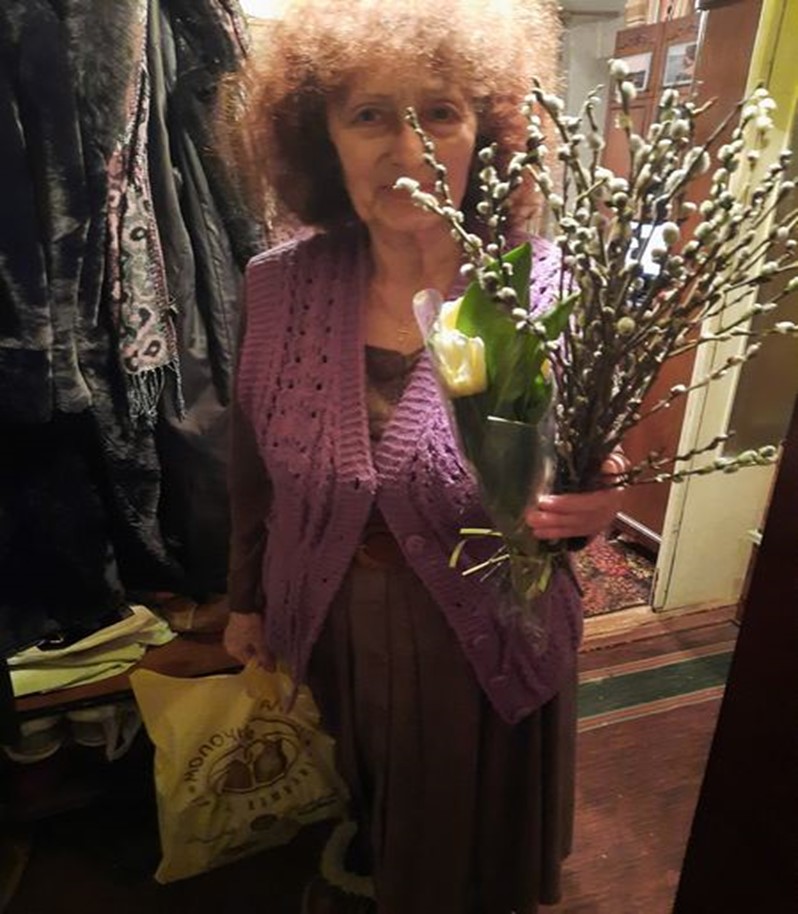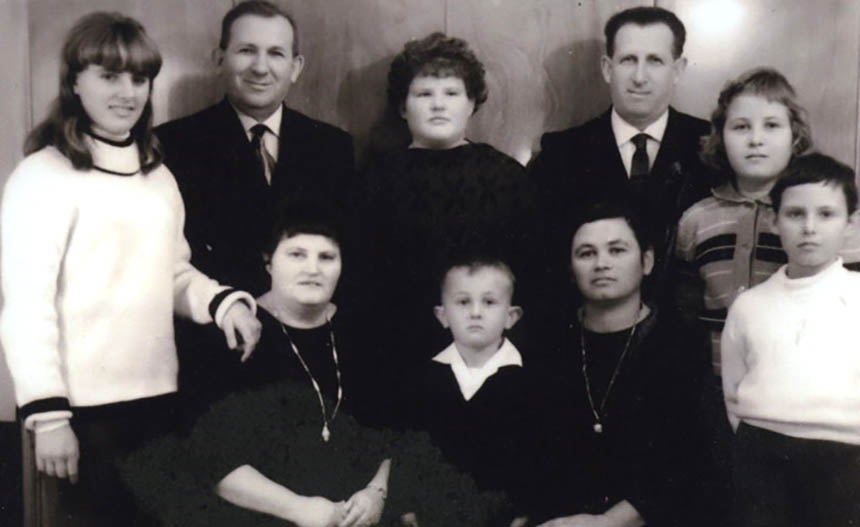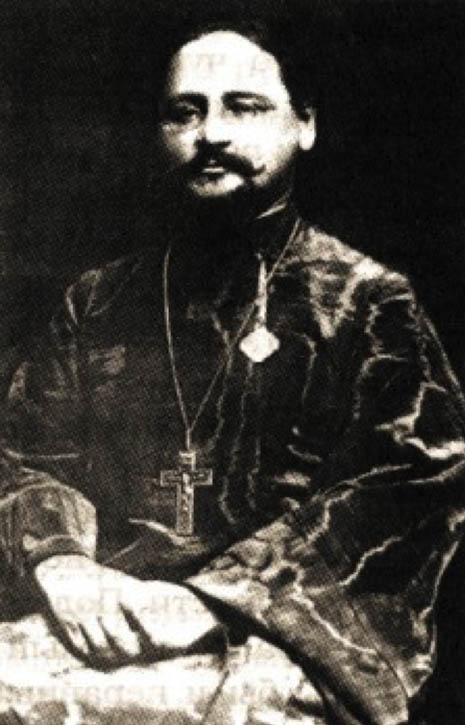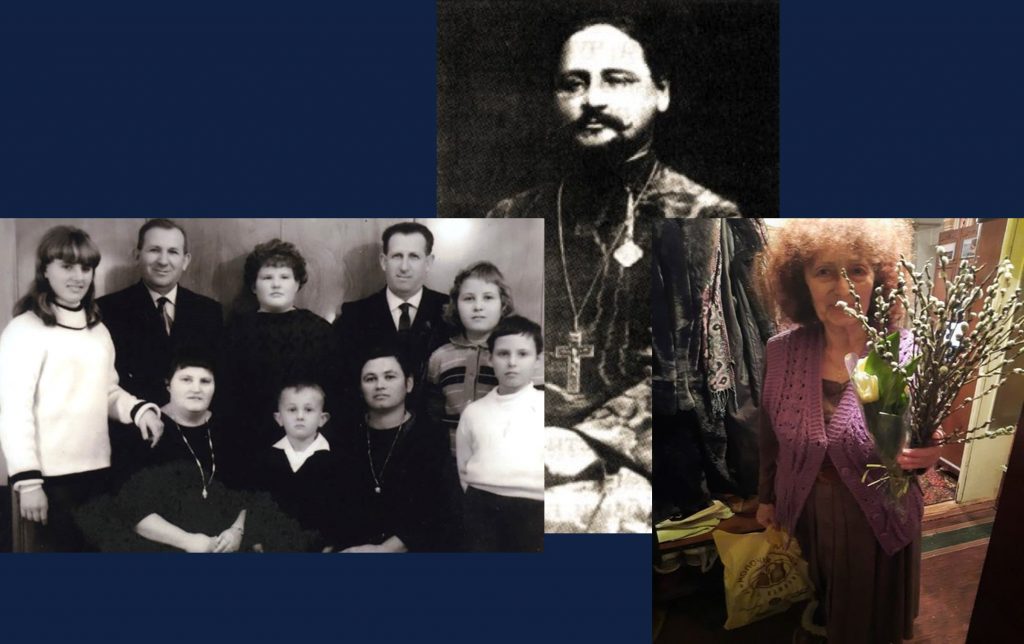Righteous Street: How Ukrainian cities honor the Righteous Among the Nations (part 2)
Toponyms in honor of the Righteous Among the Nations in Dnipro, Odesa, Rivne, and other cities
What has changed since Ukraine introduced the Remembrance Day for Ukrainians Who Saved Jews During the Second World War
One year ago, in February 2021, the Verkhovna Rada [Parliament] of Ukraine adopted the resolution "On Honoring the Memory of Ukrainians Who Saved Jews during the Second World War" and set 14 May as the remembrance day. This was to provide a new impetus to the commemoration of the Righteous Among the Nations and other Ukrainians who saved Jews during the Holocaust.
"In early 2021, we sent out an appeal to all regional administrations asking them to disseminate information about the Righteous Among the Nations in their regions and recommending that streets be named in their honor. We also provided them with links to information resources about the Righteous from their regions," says Viktoria Yaremenko of the Ukrainian Institute of National Memory. The Institute received several answers to the effect that the information would be disseminated further. "And that's all," she says.
An exception is a square named in honor of the Righteous Among the Nations in Kropyvnytskyi in the spring of 2021. A monument to the Righteous Among the Nations Ustinya Petrenko was also erected in the village of Shatura in the Chernihiv region around the same time.
Thus, the bulk of the renaming took place by 2021. In Soviet times, a street in Vorzel was named in honor of the Bilostotskyis, the Righteous Among the Nations who saved Envelina Gershman at the cost of their own lives. In 2017, the Alley of the Righteous was opened in the Peace Park in Kremenchuk, and a memorial sign dedicated to the Righteous Among the Nations was unveiled. In 2018, a street in Cherkasy was renamed in honor of the Righteous Among the Nations Oleksandra Shulezhko, who saved nearly 100 children from starvation and death, including 25 Jewish children. Part of the renamings that were carried out in the framework of the Righteous People of My City project run by the Jewish Confederation of Ukraine were discussed in the first part of the "Righteous Street."

The Institute of National Memory received a response from the Dnipro City Council, where two streets were renamed at the initiative of the "Tkuma" Ukrainian Institute for Holocaust Studies (discussed below).
At the end of the summer, the Institute of National Memory also asked the Kyiv City State Administration to rename existing streets or name new ones in honor of the Righteous Among the Nations. "We received a reply that they had been approached by the 2U Charitable Foundation with a request to rename Khokhlov Family Street in honor of the Righteous Among the Nations. In response, the Kyiv City State Administration provided the For You Foundation with a detailed description of the proper procedure. We have not received any more letters from the Kyiv City State Administration," says Yaremenko.
Julia Goldenberg, founder of the 2U Charitable Foundation, has told the Ukrainian Jewish Encounter (UJE) that "the renaming process is very complicated. In addition to many signatures and letters that need to be submitted to the local authorities, one has to collect the signatures of people residing in the street that is to be renamed, which is the most difficult part. People are afraid of this; they don't want to face any inconsistencies in documents later, and the main thing is that they don't care even when you explain to them who these figures were." (See part 1 of the study for more details.)
Lots of different procedures
The Institute of National Memory has supported the initiative of Lviv scholar and historian Yuriy Skira to rename a street in the town of Rava-Ruska in honor of hieromonk Daniil Tymchyna, one of the Righteous Among the Nations. Skira appealed to Ivan Ivanusa, the mayor of Rava-Ruska. "The Holocaust is obviously dominated by killings. We know well the biographies of executioners from school textbooks. At the same time, we know so little about those who, despite the circumstances, tried to save people," his letter reads. Hieromonk Daniil Tymchyna hid three Jewish boys in an orphanage run by the monastery in the village of Univ and taught them how to save themselves. The Yad Vashem website, for example, says that Tymchyna made sure that Jewish boys did not take showers with other boys so that they could not be identified by their circumcision. He saved all three boys. In 2008, Yad Vashem recognized Tymchyna as the Righteous Among the Nations.
"I sent a letter to Rava-Ruska in March 2021, involving many different people. We were supported by letters from the National Museum of the History of Ukraine in the Second World War, the Institute of National Memory, the Univ Holy Dormition Lavra of the Studite Rite, the Saint Joseph Monastery of the Studite Rite in Lviv, the For You [Charitable] Foundation, etc. Very influential and respectable people joined me in my request to the mayor of Rava-Ruska, asking to honor Tymchyna as the Righteous Among the Nations," says Skira. Secretary of the Rava-Ruska Municipal Council Andrii Buchko responded to the appeal, promising to have the proposal considered at a meeting of the Standing Commission on Healthcare, Education, Culture, Tourism, Youth, Sports, and Social Protection of the Rava-Ruska Municipal Council.
"We would like to inform you that after the Rava-Ruska Municipal Territorial Hromada was created, no unified procedure was put in place for renaming or naming geographical objects. On April 15, at the aforementioned meeting of the commission, the Regulation was agreed upon and approved on 21 April 2021 by the 8th session of the Rava-Ruska Municipal Council of the 8th democratic convocation. The Regulation specifies the procedure for naming or renaming geographical objects," the response read. "I received the answer in June 2021. Since then, there has been no progress in the case," Skira says.
No common denominator
Indeed, different cities now have various procedures for street naming. For example, the present author asked the Lviv mayor to name one of the new streets in honor of Stefania Petrushka, one of the Righteous Among the Nations, back in 2018.

In his response, Deputy Mayor Andrii Moskalenko wrote that, according to the rules currently in force in Lviv, a street could be named after someone no sooner than five years after their death. Petrushka died in 2018.
We also asked Kyiv Mayor Vitali Klitschko to name one of the new streets in honor of the Righteous Among the Nations Nina Gudkova who saved twelve Jewish boys. In response, a promise was made to convene a commission on renaming. That was the end of it.
Julia Goldenberg, founder of the 2U Charitable Foundation, explains: "I understand perfectly well that we must adhere to procedural norms and act within the current legislation. In 2021, the Remembrance Day for Ukrainians Who Saved Jews During the Second World War appeared on the Ukrainian calendar. It is a pity that this was done as late as last year when only a few rescuers were left alive, but it is better late than never. Towards this date, Ukraine issued its first-ever postal products (stamps and envelopes) in honor of the Righteous; films are being produced, and memories are being collected… It's good that society will learn about the heroic deeds of these special people, but it pains me that there are still no streets in big cities named in honor of the Righteous. Although not impossible to initiate, the procedure is so difficult and time-consuming that it nullifies the efforts of civil society. Also, the rules differ in Kyiv, for example, and in Lviv, which further complicates the process. We need political will and a decision so that streets/avenues/squares named after the Righteous or Ukrainian rescuers would appear in regional centers by 14 May 2022. This is very, very important, in my opinion. That would be a balanced, consequential decision."
Roza Tapanova, acting Director-General of the National Babyn Yar Preserve, says: "Many people know about the Verkhovna Rada resolution 'On Commemorating Ukrainians Who Saved Jews During the Second World War'. Its passage was a key step for the state in recognizing and perpetuating the memory of the heroes who saved Jewish lives while risking their own lives and those of their family members. To simplify the street renaming procedure, a list of the Righteous Among the Nations, the Righteous of Ukraine, and the Righteous of Babyn Yar needs to be approved at the state level. Thus, the state will once again confirm the importance of the Righteous for Ukraine and the world."
Thus, there is currently no single procedure for all oblasts and regions in Ukraine to rename streets, alleys, avenues, squares, parks, squares, bridges, and other local objects.
"In 2014, the Ukrainian Institute of National Memory, together with regional state administrations and regional councils, provided methodological assistance on unifying the street renaming procedure. Using these guidelines, most oblasts and regions apply the recommended procedure precisely.
To have one unified procedure, it needs to be fixed in a normative legal act, which may be a regulation approved by the Cabinet of Ministers," Tapanova explains.
In August 2021, the Ukrainian Jewish Encounter in cooperation with the Word of the Righteous and with the participation of the Association of Ukrainian Cities, surveyed experts (historians, officials, and philanthropists) on toponyms honoring the Righteous Among the Nations. Since then, several objects have been renamed, as discussed below.
"Our function was to draw attention to the issue," says Yaremenko.
Stumbling Stones
A new type of toponyms in honor of the rescuers is the Stumbling Stones. This is an international project to commemorate Holocaust victims and rescuers. It was founded in 1996 by Gunter Demnig. The idea was to install 10-by-10-centimeter brass-covered cobblestones with the names of Holocaust victims and rescuers. The cobblestones are installed at historic sites where events took place — near the houses from which people were taken to their deaths or where rescuers hid Jews.
"The stumbling stones to commemorate the 80th anniversary of Babyn Yar were created on the initiative of the German Embassy and are implemented by the Ukrainian Center for Holocaust Studies. Its title is 'One stone, one life — 80 stumbling stones for the 80th anniversary of Babyn Yar.' The project has a strong educational character: young people process archival documents and other sources to write the biographies of those killed or rescued and the rescuers," says Anatolii Podolskyi, Ph.D. in History, and Director of the Ukrainian Center for Holocaust Studies.
Stumbling Stones as a form of memory were launched a quarter of a century ago in Germany. In Ukraine, they are already installed in Pereiaslav, Rivne, Chernivtsi, and, finally, in Kyiv in 2021. Thus, the names of the killed, saved, and the Righteous are brought back to the urban space and modernity. The project has a website with many stories to read and think, think, think.
From September 30 to October 8, 2021, ten stumbling stones were installed in Kyiv. One was placed in Zhylianska Street — a memorial stone in honor of priest Oleksandr Vyshniakov who saved many Jews but was himself arrested and killed.

In Rivne, there is a stumbling stone honoring the Righteous Among the Nations Jakov Sukhenko.
However, the primary vehicles of historical memory are the streets. Earlier, we already talked about toponyms honoring the rescuers of Jews in Kyiv, Kharkiv, and Lviv.
Dnipropetrovsk region
Significantly for Ukraine, streets were renamed in honor of the Righteous Among the Nations in the Dnipropetrovsk region, such as Jan Chodorowsky and Vasiliy and Mariya Zubkov streets in Dnipro (2019). Chodowsky's story is told by the Righteous in My City project run by the Jewish Confederation of Ukraine (JCU). This Polish young man saved 26 Jews. "He knew German perfectly and lived in Lviv. Jan Chodorowsky, an engineering student, was entrusted with recruiting personnel for construction work. He deliberately recruited 26 Jews into the brigade and forged documents for them, presenting them as Ukrainians and Poles," the JCU portal says. Chodorowsky's brigade was sent to Dnipropetrovsk, and all the Jews were saved.
Vasiliy and Mariya Zubkov hid the Jewish girl Nelli Gordon and saved her life.
According to the Dnipropetrovsk Regional State Administration website, fourteen streets in the Dnipropetrovsk region are named after those who saved Jewish lives during the Holocaust. These are streets in Dnipro, Kamianskyi, Nikopol, Novomoskovsk and in the Krynychky, Mahdalynivka, Dnipro, Nikopol, Synelnykove raions.
"In Kryvyi Rih, a memorial plaque was unveiled on a wall of the Central City Lyceum in honor of the Righteous Among the Nations Zinaida Mekelito. The city has many people who are officially or unofficially the Righteous Among the Nations, and their deeds are duly honored. In my opinion, it would be correct to name one of the central streets in Kryvyi Rih' Street of the Righteous Among the Nations," argues Svitlana Piddubna, Director of the Mykhailo Marmer Museum — Museum of Jewish Culture and Holocaust History in Kryvyi Rih.
Zinaida Mekelito was a teacher of the Russian language and literature. Her family sheltered several Jews during the Holocaust, including Boris, Irina, and Nadezhda Reinish. Thus, according to the Yad Vashem Holocaust Memorial Center portal, Mekelito saved two men who had returned from the front: her former student Veniamin Gdolevich and Boris Muravski, the principal of the school where she worked before the war. She gave Boris the ID of her husband, who had been deported to Siberia in 1937.
A memorial plaque in honor of Mekelito was put up in 2019.
According to Piddubna, honoring the heroic deeds of Ukrainians during the Second World War is essential for several reasons: "Tragic and heroic memory contributes to the formation of a culture of historical memory in society. Heroism associated with mortal risk is a righteous act. The memory of the heroic deeds of specific people is a tribute to them. Pride in the heroism of compatriots shapes the national self-awareness of civil society, a political nation.”
Odesa
The legendary Shevalev doctors — psychiatry professor Yevgeny Shevalev and his son Andrey — rescued three hundred Jews in Odesa. In honor of their feat, a memorial plaque was put up on the hospital building where they rescued people.
Here is what the Yad Vashem website says about Yevgeny Shevalov's heroic deed: "Yevgeny Shevalev, a professor of medicine, was head of the department of psychiatry at Odesa University. During the war between Germany and the Soviet Union, Yevgeny was the director of the psychiatric hospital in the city, in which close to 600 patients were treated. Since the start of the occupation, in October 1941, he was confronted with problems such as feeding the patients and a shortage of medicine. In particular, however, he was faced with humane issues concerned with protecting the Jewish patients and workers. To resolve this problem, he filled out about 20 new 'patient cards' on which he recorded fictitious names. This enabled him to permit the Jewish workers to stay in the hospital under the guise of being patients. One of these was Mikhail Gershenzon, a paramedic, and Gita Vekselman, a nurse. Later, with the help of his son, Andrey, who was a 22-year-old biology student, and some of the members of the staff, Yevgeny managed to change the names of the Jewish patients in other departments so that towards the beginning of 1942, not a single Jewish name remained on the list of patients. Yevgeny also devised a means by which to, at least partially, solve the problem of supplies; he and members of his staff sold some of the possessions and personal belongings of patients who died to obtain funds to purchase food and supplies. Although he distributed everything he obtained among the patients, some still starved to death during the hard winter of 1941–1942. At the same time, Yevgeny continued to badger the city authorities to help support the institution he headed, and towards the spring of 1942, he met with success. Among the Jews who found refuge in the hospital were some friends of the Shevalevs from before the war."
Odesa also has an alley dedicated to the Righteous Among the Nations in Prokhorov Public Gardens. Roman Shvartsman, chairman of the Odesa Regional Association of Former Jewish Ghetto and Nazi Concentration Camp Prisoners, explains: "Birches grow there in honor of the Righteous. We had 220 Righteous Among the Nations in Odesa when we started registering them in 1991 as Ukraine became an independent state." To date, only one of them, Olympiada Danilyants, remains among the living.
The alley in honor of the Righteous was established with the involvement of the Odesa Regional Association of Former Jewish Ghetto and Nazi Concentration Camp Prisoners and with the support of Yakov Manovich, a former prisoner of the Bogdanov ghetto.
According to Shvartsman, there is also a memorial plaque in Balta, Odesa region, dedicated to Queen Helen of Romania, one of the Righteous Among the Nations. Helen of Greece and Denmark, the wife of the Romanian King Carol and the mother of the Romanian King Michael I, helped the wounded during the Second World War and was instrumental in saving Transnistrian Jews.
The most critical development in honoring the Righteous in the Odesa region is a 2021 decision to rename Chervonoslobidska Street as Righteous Among the Nations Street. It is located on the site of the Odesa ghetto. According to Shvartsman, the decision has already been passed, and the legal procedures are now being completed.
"I believe that, by creating toponyms in honor of the Righteous, we, first, spread information about them and, second, make people stop and think about the present. There are always those who oppose criminal authority, just as the Righteous Among the Nations opposed and acted against those who sought to destroy the Jewish people. The criminal Nazi government persecuted Jews only on the basis of their birth," Podolskyi says.
He adds that the Righteous were heroes who sacrificed themselves for the sake of others: "By introducing toponyms in their honor, we issue reminders that there have always been such heroes in Ukraine and that we should always fight for freedom, human dignity, and human rights and that we must always control the authorities because when they are out of control, dictatorial regimes arise and crimes against people are committed. Thanks to toponyms honoring the Righteous Among the Nations, Ukraine shows a culture of remembrance and a culture of honoring the rescuers of those who were doomed to death by the occupying power during the Second World War. The emergence of new place names in honor of the Righteous should result from joint work of the government and civil society. It's great when officials want to be educated and are willing to understand issues and listen to civil society."
P.S.
Appendix (comment by Rosa Tapanova):
Currently, the following procedure is followed in most regions of Ukraine:
- Proposals for a (new) street name are collected. Individuals and legal entities can submit proposals. The initiative should be properly documented (e.g., in a letter, minutes, etc.) and submitted to the executive committee of the local council.
- An order is issued to set up a street naming commission, and the respective Regulation is approved.
- The commission considers proposals submitted by legal entities and individuals on renaming streets, alleys, etc., and passes a decision, documenting it in the minutes of its meeting and instructing the relevant department to draft a decision of the executive committee and submit it to the next meeting.
- A public discussion is held, and the issue is considered at a public hearing, a general meeting of local residents, or a local referendum.
-
- The time period within which the public discussion must be held is calculated starting from the date when the relevant announcement is published and should be no less than two months.
- The announcement about the public discussion is published by local self-government authorities on their official website or in another acceptable way.
- Public discussion participants submit their proposals (comments) in writing or orally, no less than thirty days from the announcement's publication.
- The executive committee of the village, settlement or city council approves the new street name and instructs the relevant department to submit the renaming proposal to the council.
The council passes a decision on (re)naming the object in question.
The first part discussed toponyms in honor of the Righteous Among the Nations in Kyiv, Kharkiv, and Lviv.
We thank the Association of Ukrainian Cities and the Ukrainian Institute for Holocaust Studies for their help in obtaining information about place names in honor of the Righteous.
Marharyta Ormotsadze
Marharyta Ormotsadze is the co-founder/producer of the Word of the Righteous project that tells about the valor of Ukrainians who saved Jews throughout Ukraine during the Holocaust.
Read Part One of “Righteous Street: How Ukrainian cities honor the Righteous Among the Nations” here.




















